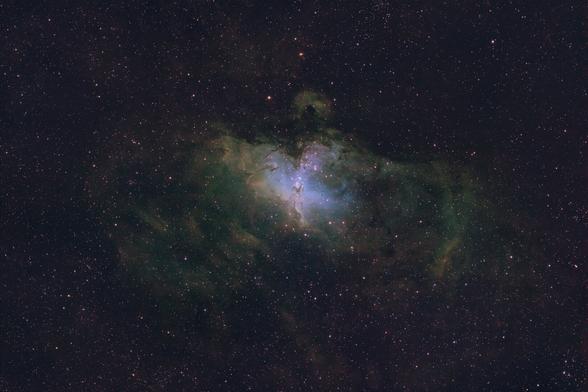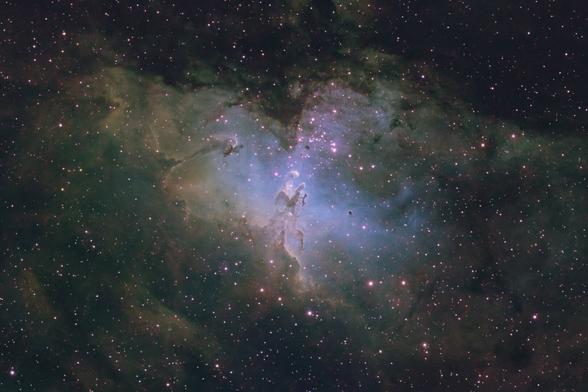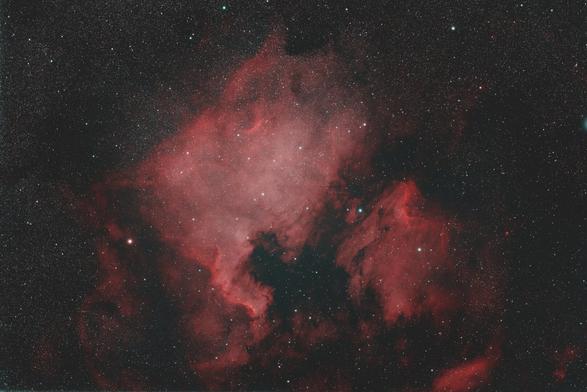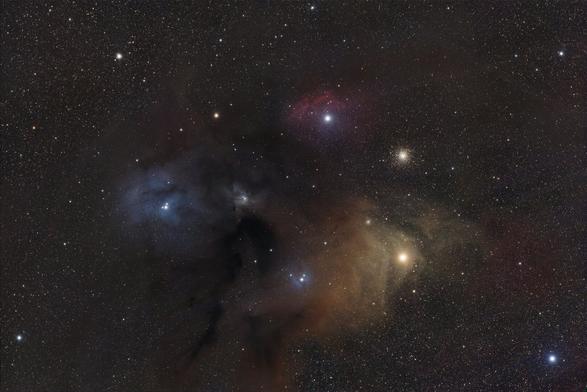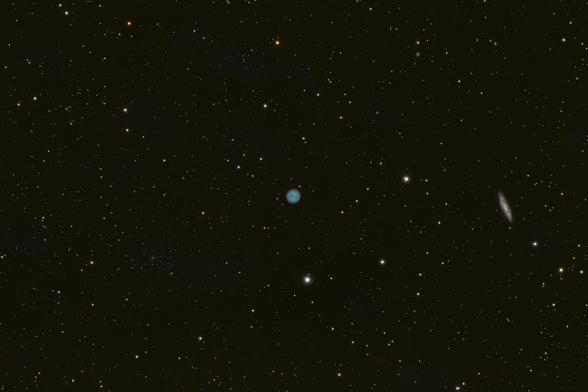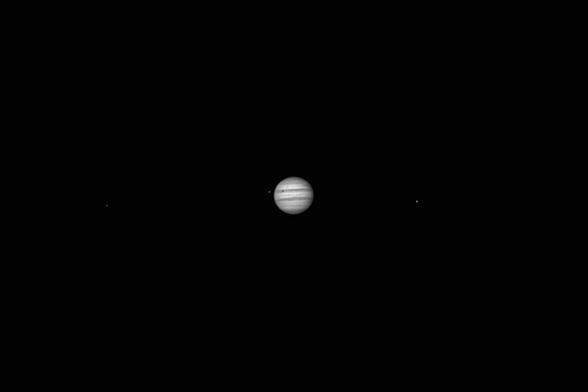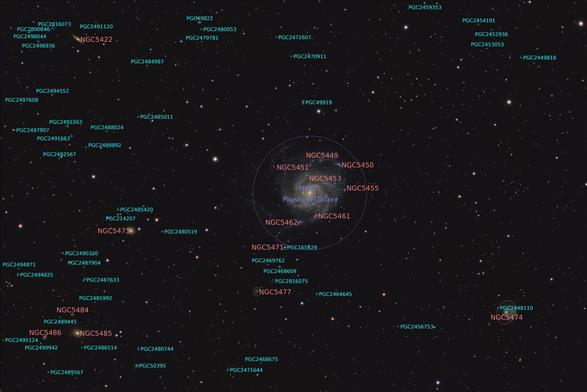Mallory
This is where I shared my astrophotography without all of the drama.
I should say that the reason I got the Altair set though is because Askar only makes the Color Magic duo-band filters in 2" and I wanted 1.25" filters for my ASI585MC. So that could also be a deciding factor too.
I like both of them, but the Altair set has a narrower bandwidth than the Colormagic filters. I could only get the C1+C2 filter set at the time, but Askar also has higher-quality D and E sets which I'm sure are just as good as the Altair ones. The C set is super cheap though (as far as 2" filters go, anyway).
If I had to start over and pick only one, I'm not sure which I would choose.
If I had to start over and pick only one, I'm not sure which I would choose.
Thanks! 😊
This image was somewhat complex to process because it was captured by two telescope rigs simultaneously.
Rig 1 details:
- Askar 130PHQ w/ 0.7x reducer
- ZWO ASI2600MC
- iOptron HAE29
- 20x180s Askar Color Magic C1 (H+O) filter
- 20x180s Askar Color Magic C2 (S+O) filter
Rig 2 details:
- William Optics RedCat 51
- ZWO ASI585MC
- iOptron HAE16C
- 10x180s Altair 6nm Ha+OIII filter
- 30x180s Altair 6nm SII+OIII filter
- Stacked and edited in PixInsight w/ BlurX, NoiseX, and StarX
Rig 1 details:
- Askar 130PHQ w/ 0.7x reducer
- ZWO ASI2600MC
- iOptron HAE29
- 20x180s Askar Color Magic C1 (H+O) filter
- 20x180s Askar Color Magic C2 (S+O) filter
Rig 2 details:
- William Optics RedCat 51
- ZWO ASI585MC
- iOptron HAE16C
- 10x180s Altair 6nm Ha+OIII filter
- 30x180s Altair 6nm SII+OIII filter
- Stacked and edited in PixInsight w/ BlurX, NoiseX, and StarX
Here's my first pass at data I captured last night (June 14) of the Eagle Nebula (M16) in SHO narrowband.
Just a reminder of what SHO narrowband means:
- Red shows light emitted by sulphur
- Green shows light emitted by hydrogen
- Blue shows light emitted by oxygen
The second image is a smaller crop around the center of the nebula to show off the details of the so-called "Pillars of Creation"
#astronomy #astrophotography
Just a reminder of what SHO narrowband means:
- Red shows light emitted by sulphur
- Green shows light emitted by hydrogen
- Blue shows light emitted by oxygen
The second image is a smaller crop around the center of the nebula to show off the details of the so-called "Pillars of Creation"
#astronomy #astrophotography
Hmmm... maybe I'll get a pic of GAL 084.0+00.8 with my 8" EdgeHD if I get a chance.
The North American Nebula (NGC 7000) and Pelican Nebula (IC 5070) in HOO narrowband. These two nebulae are in the constellation Cygnus and are about 2,600 light-years away.
Captured from June 8-10, from my apartment and an annoying amount of smoke in the air. Oh yeah, and it was a full moon.
Details:
- RedCat 51
- ASI2600MC w/ Askar Colormagic C1 filter
- 111x300s
- PixInsight w/ BlurX and NoiseX
#astronomy #astrophotography
Captured from June 8-10, from my apartment and an annoying amount of smoke in the air. Oh yeah, and it was a full moon.
Details:
- RedCat 51
- ASI2600MC w/ Askar Colormagic C1 filter
- 111x300s
- PixInsight w/ BlurX and NoiseX
#astronomy #astrophotography
This is the pic I got on Sunday night of the Rho Ophiuchi Cloud Complex.
If you look closely, you might see some artifacts in the image because a power pole appears in a few of the subframes. This area is very low in the sky at my latitude which made it difficult to get the data as clean as I'd like. I decided that I should try to collect more data if I can, so this isn't the final version, but it's still cool.
#astronomy #astrophotography
If you look closely, you might see some artifacts in the image because a power pole appears in a few of the subframes. This area is very low in the sky at my latitude which made it difficult to get the data as clean as I'd like. I decided that I should try to collect more data if I can, so this isn't the final version, but it's still cool.
#astronomy #astrophotography
Here's my take on one of the classics: the Whirlpool Galaxy (M51)
It's technically two galaxies (NGC 5194 and NGC 5195) about 23-31 million light-years away from us in the process of merging. It will eventually be a featureless blob of a lenticular galaxy, but at the moment it's a mesmerizing sight.
#astronomy #astrophotography
It's technically two galaxies (NGC 5194 and NGC 5195) about 23-31 million light-years away from us in the process of merging. It will eventually be a featureless blob of a lenticular galaxy, but at the moment it's a mesmerizing sight.
#astronomy #astrophotography
I've seen some great pics come out of Seestars. The biggest things that will help you are using it in equatorial mode and saving the subs off for processing in something like PixInsight or Siril.
The rig I used:
- Askar FMA180pro
- ZWO ASI585MC
- iOptron HAE16C
- ASIair Plus
- Askar FMA180pro
- ZWO ASI585MC
- iOptron HAE16C
- ASIair Plus
Oh, trust me, there was plenty of crud from light pollution that I had to edit out to get it too look nice lol
The pic I got last night was of the Owl Nebula (M97) and the Surfboard Galaxy (M108).
The Owl Nebula is a relatively young and relatively close planetary nebula about 2,000-ish light years away. The Surfboard Galaxy, on the other hand, is about 46 million light years away.
#astronomy #astrophotography
The Owl Nebula is a relatively young and relatively close planetary nebula about 2,000-ish light years away. The Surfboard Galaxy, on the other hand, is about 46 million light years away.
#astronomy #astrophotography
Why would you call the back side of the moon "dark" when it gets just as much light as the front?
Stacked video
Askar 130PHQ w/ 0.7x reducer (700 mm focal length, f/5.4) and ZWO ASI2600MC camera
Celestron EdgeHD 8" with 0.7x reducer and a ZWO ASI294MM camera
And while I was setting up on Tuesday night (Apr 29), I was impressed by how the moon looked and took a some pics of it. It was cool to be able to see the literal dark side of the moon as it reflected earthshine back at us.
#astronomy #astrophotography
#astronomy #astrophotography
I also got a quick pic of Jupiter on Sunday night (Apr 27) while I was setting up. Only in Luminance because I was using my monochrome camera at the time, but it still turned out really well.
When I was capturing the image, I thought I was seeing the Great Red Spot, but it looks like it's the shadow of one of the moons (Io?)
#astronomy #astrophotography
When I was capturing the image, I thought I was seeing the Great Red Spot, but it looks like it's the shadow of one of the moons (Io?)
#astronomy #astrophotography
Client Info
Server: https://mastodon.social
Version: 2025.04
Repository: https://github.com/cyevgeniy/lmst
